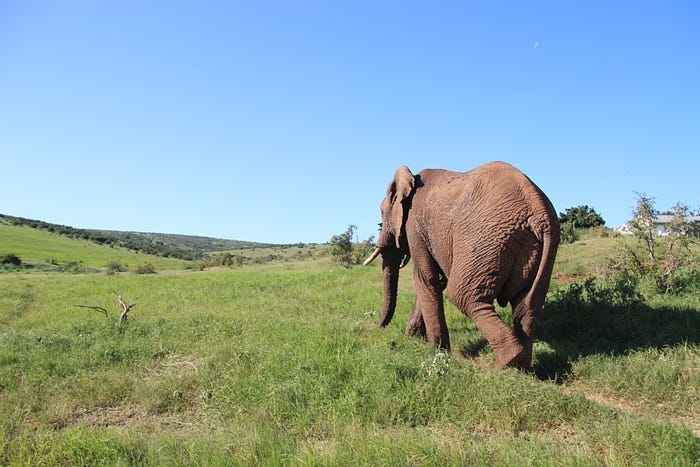He Crossed The Alps On A Borrowed Elephant To Prove A Point
An engineer finds the ultimate out-of-the box method to answer a question about Hannibal

I’ve been a fan of history ever since I was little. The thing that gets me is the captivating stories, which are often better than anything a Hollywood producer could dream up. Although it often comes down to talented ordinary people doing the impossible. For instance, there’s Hannibal Barca.
This Carthaginian general took about forty elephants and fifty-thousands soldiers across the Alps to attack Rome. It might be the greatest surprise attack in all history. After all, mountains are a natural barrier, not to mention pulling pachyderms across them. Talk about impossible.
It’s such a stunning feat, no one knows exactly how Hannibal did it.
Particularly what route did he take? Everyone from Napoleon Bonaparte, historians, and know-it-all nerds have ideas, but from the sketchy evidence left, it’s all speculation. This brings us to John Hoyte.
In the late 1950s this engineer thought he figured it out. He hiked a path a few times, and it seemed like a logical route. But he wanted to prove he was right to a skeptical world and came up with one of the craziest ideas of all time to do it.
He’d get an elephant and cross the path himself, proving it was possible.
If you’re reading this, I already imagine you’re an intelligent and inquisitive person. But reread the sentence above and think about it. Where do you get an elephant? Then, how do you prep it to walk across a mountain?
A Proper British Way To Acquire / Equip An Elephant
“Someone casually asked me, ‘Why don’t you take an elephant over to test out your theory?’ I couldn’t sleep for thinking of the possibilities. Imagine manhandling a live elephant over Hannibal’s pass…The next morning, expecting little response, I wrote to inquire of the British Consuls…whether they knew of an elephant for rent. Only a week later came a reply from Turin: ‘Dear Sir: Unaccustomed as I am, as Her Majesty’s Consul General, to receive such requests, I am delighted to tell you that I have an elephant for you.’…Little anticipating the problems and challenges that lay ahead, I accepted.”
- John Hoyt, In Hannibal’s Elephant Tracks
While Hoyt’s expedition promised to be a challenging one, even the preparation before the trip wasn’t easy. Surprisingly, the elephant wasn’t hard to acquire. A zoo owner in Turin offered an eleven-year-old circus elephant named Jumbo rent-free.
A friend of Hoyt, Dr. Patrick Hunt, says the zoo had problems with Jumbo. She had too much energy, and they figured a long walk might do her some good. The publicity of the event wouldn’t hurt either.
Hoyt and some friends began to organize a team, called The British Alpine Hannibal Expedition. It included a veterinarian, elephant trainer, classicists, photographer, and friends of Hoyt who took on many hats, including treasurer and linguist.
Money covering the trip was raised from many sources, including an article published by Life Magazine, documenting the journey.
After consulting the animal experts, the team now realized a 5,700 lb. elephant would need its own special goody bag for the trip. According to Hoyt, this included:
“150 pounds (68 kg) of hay, 50 pounds (23 kg) of apples, 40 pounds (18 kg) of bread, 20 pounds (9.1 kg) of carrots, and a vitamin B supplement per day”
They also insured the elephant through Lloyd’s of London.
But there was another concern: eventual complaints from animal right’s activists. Any poor elephant marching across a mountain could suffer injuries due to cold or stepping on sharp rocks. So, Hoyte and his team took an inventive approach.

They ordered giant leather boots and a coat for Jumbo.
Lotus Ltd., created four boots made of canvas with leather souls, fit for an adventurous pachyderm. It took the company about two months. The results were amazing and fit like a glove, er, boot. But the coat was a collaborative effort by multiple sail makers.
Hoyte’s team also settled to make the journey in the summertime, avoiding treacherous winter conditions.
Although Hannibal wasn’t as lucky.
The Original Hannibal Expedition

“Modern historians have posited numerous theories about Hannibal’s exact course through the Alps. Proposed routes have included the low passes at Montgenèvre, Little St. Bernard, and Mount Cenis, as well as the high passes at Col du Clapier–Savine Coche and Col de la Traversette.”
According to The Encyclopedia Britannica, Hannibal’s path was treacherous, involving struggles with terrain, weather, and tribes of hostile Gauls along the way. So, not only did he have to cross narrow paths, but endure tribes rolling boulders on his head.
Both ancient writers Polybius and Livy give vague descriptions of Hannibal’s exact route. However, both indicate his way took him to an extremely high elevation; snows from the previous winter were even still present. Although the exact route is highly debated.
In recent years, the Col de la Traversette, has taken on new interest after a scientific team found a treasure trove of ancient animal manure, indicating a large collection of mammals passed through the area about the time of Hannibal’s crossing.
While about a hundred years before, Napoleon — who crossed the Alps with an army himself — favored the Col du Mont Cenis. Although Hoyte was convinced it was Col du Clapier.
Needless to say, Hannibal made the trek in fifteen days, with most of his forces intact. It’s utterly impressive when you think about it. The Carthaginian’s army consisted of a large group of warriors from diverse lands, which spoke different languages, ill-prepared for mountain conditions, and facing determined tribal enemies.
Hoyte’s team included eight hand-picked experts, a happy elephant with a posh set of boots, and a native public who embraced them with open arms.
The British Alpine Expedition’s Trek
“July 20, 1959 — Good morning, Hannibal. This is the first day of our journey and quest to rediscover your route over the Alps. We seem to have enough information – particularly from Polybius – to know your passage…We believe we are the first to take an elephant along your route since you did, so, in a sense, we will be travelling with you.”
— John Hoyte, St. John’s College, University of Cambridge Website
Life Magazine documents a journey much different than Hannibal’s. Mayors from villages along the path gave speeches welcoming the group, and children sang songs saluting the elephant. Dr. Hunt says Jumbo covered about four miles an hour, but a little faster when really determined.
The magazine got exactly what they wanted out of the event. It was a publicity goldmine. The elephant was having a blast, loved people, and good-naturedly posed for photos.
Although the journey did run into complications. Hoyte’s team was notified their designated route through the Col du Clapier had been compromised by rockslides. After careful consideration, they trekked backwards to an alternate path.
They chose a lower route crossing the Col du Mont Cenis — Napoleon’s choice.
Overall the trip was a smooth process. The team “invaded” Susa, in Italy within about ten days. They were greeted by adoring crowds that walked them through the Triumphal Arch, built in honor of Caesar Augustus.
Despite the easy trek, Jumbo lost five hundred pounds in the process. One could only imagine what shape Hannibal’s elephants and troops were in as they descended into Italy.
The Impossible Is Possible With Effort

While John Hoyte didn’t prove his original theory about Hannibal’s chosen path, he did show us something. Events in the past often cloud our vision. We see our ancestors as primitive and lacking our modern sophistication.
For instance, how could an ancient Carthaginian cross a mountain chain with elephants?
While they didn’t have satellite phones or GPS, they weren’t unsophisticated. Hannibal was a natural leader. He had an innate ability to motivate those around him to cross rivers, climb mountains, and smash the Roman Empire.
Plus, while our mind sees a cumbersome elephant climbing Mt. Everest, the path across the Alps wasn’t exactly like that. Hannibal faced a bigger threat from humans than nature, although nature wasn’t exactly kind. Hoyte never faced any snow, while Hannibal and his troops did.
Hoyte’s experiment shows us taking an elephant across the Alps is doable. In fact, it’s relatively easy depending upon the time of year you choose, and if the natives are friendly.
Moreover, our ancient ancestors may have had primitive technology, but their ability was far from primitive. They could even show us a thing or two about leadership and perseverance.
By the way, if you’d like to learn more about John Hoyte’s journey, he covers it in his recent memoir Persistence of Light.
-Originally posted on Medium 6/22/22


